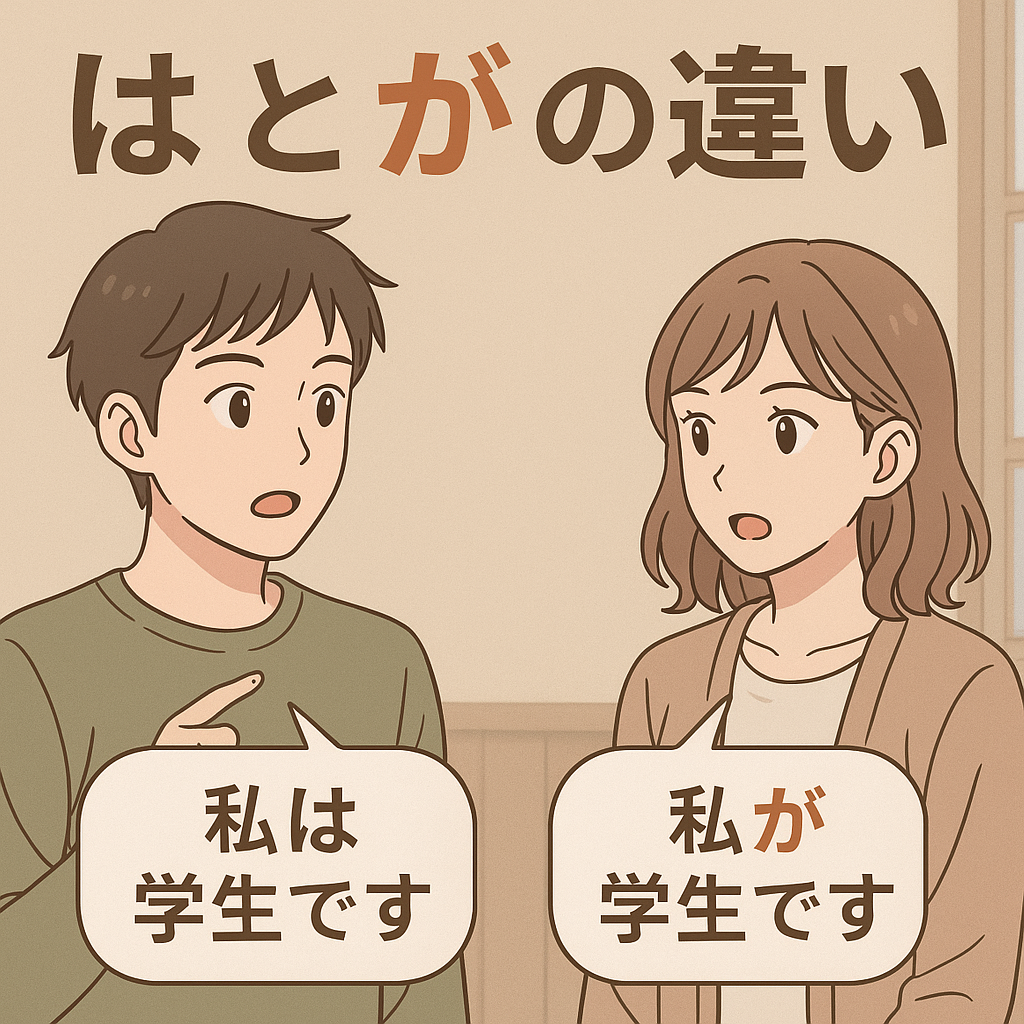
The difference between は and が that textbooks don't teach
「は」vs「が」– The difference textbooks don't teach you
If you've been studying Japanese for a while, you've probably been confused by these two seemingly basic particles: は and が.
In textbooks, they are often simply explained as:
- 「は」is the topic marker
- 「が」is the subject marker
However, in reality, the difference between these two is much more complex and subtle. Many learners, even at the intermediate level and above, still make mistakes, especially when they need to express nuances of emphasis, contrast, or in natural daily conversation.
📌 When to use「は」? When to use「が」?
Instead of learning dry theory, let's look at a familiar example:
「お客様のご案内については、私がやります。」 Translation: Regarding guiding the customers, I will do it.
Here:
- 「は」 appears after the phrase お客様のご案内について, to define the topic being discussed – “the matter of guiding customers”.
- 「が」 appears before やります, to indicate who is performing the action – it is the speaker, “I”.
🟨 When to use「は」?
「は」– When you want to compare, contrast, or define a topic
When you use「は」, you are bringing up a topic that is already known or being discussed in the context. It's like saying: “As for that matter…”
Examples:
-
私は学生です。 (I am a student.) → The topic is “I”, which the listener may already know or guess.
-
この仕事は田中さんがやります。 (As for this job, Mr. Tanaka will do it.) → The topic is “this job”; it emphasizes that the action is Tanaka's.
🟦 When to use「が」?
「が」– When you want to identify the subject, to clarify who/what
Conversely, 「が」is used when you want to emphasize who is performing the action, or when you are introducing new information that the listener doesn't know.
Examples:
-
私が学生です。 (I am the one who is a student.) → Used to distinguish among several people.
-
誰が来ましたか?— 山田さんが来ました。 (Who came? – Mr. Yamada came.) → Answers the key question of “who” the asker wants to know.
✅ Summary comparison of「は」and「が」
| Particle | Emphasizes | Used when | Example | Meaning |
|---|---|---|---|---|
| は | Information after the particle | Topic is known, want to talk about something | 私は学生です。 | I am a student (introduction) |
| が | Information before the particle | Emphasizing the subject or answering a question | 私が学生です。 | I am the one who is a student (distinguishing) |
💡 Memory tips for beginners
- は is used to "orient the topic" – like saying "As for..."
- が is used to "shine a spotlight" on the subject – like saying "It is..."
- When answering questions starting with 誰が / 何が (who / what), always use が in the answer
💬 Real conversation
A: この中で、誰が田中さんですか? B: 私が田中です。
→ Here, it's not a general “I am Tanaka,” but “I am the one who is Tanaka” – identifying oneself among the people being asked about.
❌ Common mistakes when using「は」「が」
-
Overusing「は」: Learners often use「は」all the time, even when emphasis is needed → making the sentence unnatural.
-
Using「が」when the topic is already clear: Example:
- ❌ この本が面白いです。
- ✅ この本は面白いです。 → If the book has already been mentioned, you should use「は」to continue the topic.
🎯 Conclusion
The distinction between「は」and「が」is not just grammatical knowledge – it's about sensing the context, the purpose of speaking, and the nuance of what you want to convey.
You can't master it just by memorizing definitions, but you need to:
- 🔁 Listen a lot
- 🗣️ Imitate how Japanese people speak
- 🔍 Analyze sentence patterns in real life
If you are studying for the JLPT? 👉 Pay special attention to the particle-filling section – where your “language sense” is most clearly tested.
Thẻ liên quan:
Lan tỏa kiến thức
Chia sẻ những điều hay ho với bạn bè